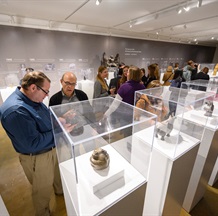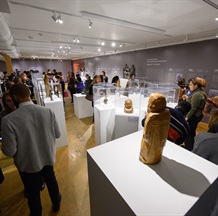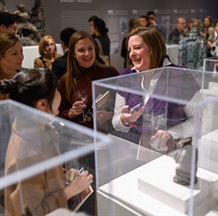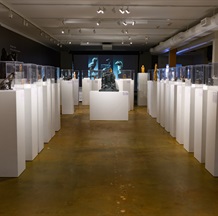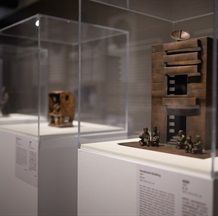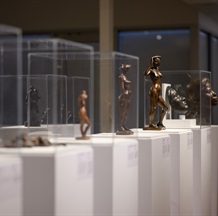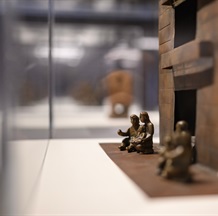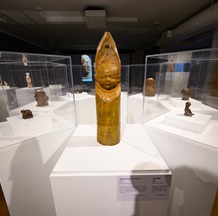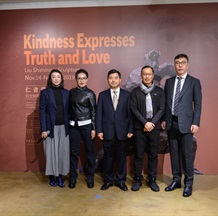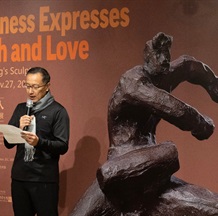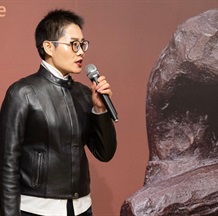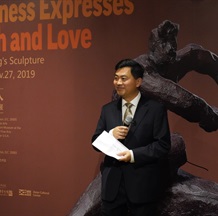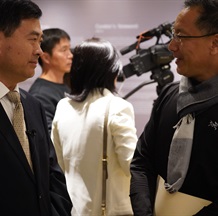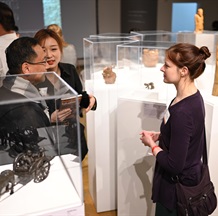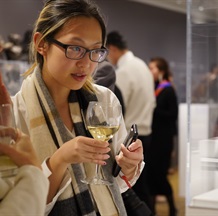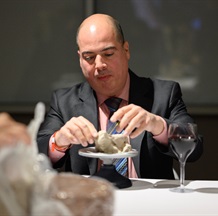In accordance with the instant feedback and comments from viewers in Washington D.C., “Daily Life”, “Social Vision” and “Life and Spirit” etc. were vital words to expand a further discussion. Through communicating with different viewers in the opening ceremony, I realized that even if Liu Shiming’s sculptures were placed in a non-Chinese context, his work could immediately arise viewers’ curiosity and empathy. Some spectators were impressed with Liu’s dynamic motion depicted by rough and simple lines; some were attracted by the figures’ rich emotions and expressions; while others may associate the diverse life scenarios depicted by Liu Shiming with their own life experience. With these first impressions, Liu’s works subtly guided viewers to explore how the figures, emotions and experiences in a particular stage of Chinese history were born and developed. In this case, the exhibition enabled the conversation based on Liu’s sculptures to be extended to the reading and exploration of Chinese culture and history.
If we take “humanist spirit” as the entry point to explore this exhibition, it works the difference between diverse languages. Standing at the intersection of Chinese and Western cultures, it leads spectators to step into Liu Shiming’s art world. It is interesting to notice that without any cultural context and language support, viewers can still interact with Liu’s artworks and develop further conversations. This phenomenon could be understood from the traceability of the concept of “humanist spirit”.
I. “Humanist Spirit”: The Intersection of Chinese and Western Cultures
In the current Chinese context, the word “Ren Wen” (CN. 人文) and related concepts are translated from the notion of “humanism” in the West. Generally, its introduction is considered as the result of “the spread of Western studies to the east”. However, tracing back to the development of Chinese history, the core of the “humanist spirit” has sprouted as early as the beginning of the Western Zhou Dynasty. In the long period of social and cultural change, it has always been rooted in the national context with a tenacious attitude that acts on different historical periods.
During the evolution of Western culture, it is generally believed that the humanistic spirit originated from the humanist movement during the European Renaissance. As early as the ancient Greek period, a spontaneous humanistic spirit was reflected in many philosophers’ contemplation and caring society. [1] Among them, the maxim “Know thyself” carved onto the door frame of the Temple of Apollo at Delphi alerted the people in the heyday of ancient Greece to awaken their self-cognition. When Immanuel Kant was talking about the enlightenment using the German word “Anthropologie” (EN. Anthropology), he placed emphasis on the philosophical question in terms of the nature of enlightenment rather than a biological or species issue. It boils down to four questions, namely, “What can I know?”“What Should I do?”“What do I want” and “What is a person?”[2] Among these four questions, the last one is usually considered as the core of Western humanitarianism and Western philosophy. The issue “what is a person” echoes the maxim engraved on the Temple of Apollo at Delph, guiding people to reflect on self-knowledge, independence and self-improvement.
In the traditional Chinese context, the essence of cultural life lies precisely in the humanistic spirit. The sociological significance of “human” in this context emphasizes his or her interpersonal relationships within society. In the most typical Confucian philosophy, the proposition of Confucianism and Mencius explored kindness as the foundation of all morality. Furthermore, the political and economic claims based on it essentially observed the interrelationship between humans in society. In “Spiritual Value of Chinese Culture”, the author Zhao Liangxing holds the view that the Chinese humanities, especially the Confucian humanist spirit, is primarily embodied as a “consciousness of suffering”(CN. 居安思危), which urges people to comprehensively reflect on the relationship between the world and themselves. [4] Hence, by placing individuals into social groups, the connotation of humanistic spirit in China mainly discusses the social aspect of human beings.
As the essence of humanitarianism, the humanist spirit is born and inherited respectively in Chinese and Western cultural soils. In Liu Shiming’s sculptures, concerning “human” is a significant motivation and inspiration for his creation. As an artist, Liu Shiming is pure and natural, so the figures in his works are simple and lively. He depicted the customs of the loess cave dwellings, daily life and authentic emotions of people from the lower class. These figures are free from the material temptation and present a natural lifestyle. Therefore, his works focus on the pure and natural “human” fit into the tradition of humanistic spirit in both the East and the West, enabling viewers to resonate deeply.
II. Making Sculptures based on Human: An Innocent Heart
The exhibition in Washington D.C. presented more than sixty bronze works that Liu Shiming personally cast during his lifetime through four sections. Namely, “The Meaning of Life: Artifact Study at the National Museum”, “The Essence of Life: An Innocent and an Innocent Heart”, “Real People: Life in the Ordinary World” and “Ideal People: Joy in the Ordinary World”.
Since Liu Shiming chose to leave Beijing for Henan in 1961, daily dialogue with the lives of the people at the bottom has become the focus of his artistic creation. During this period, Liu accumulated the primary materials for his sculptural creation including Yu Opera performers, hawkers, boatmen besides Yellow River, wood platoons around Yangtze River area, and the flow of people at the station etc. However, all these scenarios and figures entering his mind would not be immediately transformed into sculptures. Instead, he needed a period for precipitation and reflection. Liu Wei, the son of Liu Shiming, recalled that Liu would not create works based on immediate reflection. “Every night before sleep, what he saw and perceived during the day would flash like film clips in his mind. After a while, someone or something that is still engraved in his mind would be transformed to the object of his sculpture. For him, this is what touched him profoundly.” Being an authentic person and creating sincere art as Liu Shiming requires the expression deep in the heart. Only by reflecting and precipitating memories and experiences can the artistic transformation of life touch viewers to a great extent.
As a simple person, art creation for Liu Shiming was naturally pure. When viewing his works, spectators can observe the epitome of an era or a group of people as well as perceiving the dynamic relationship between individuals and society. Liu clarified that his works depicted people in communities as he believed people are social beings and creators of art. In the exhibition, the work “Re-Education” portrayed the scene that a decentralized cadre was watching watermelons in the shed with a farmer during the Great Cultural Revolution. The old peasant took a cigarette and was content with himself in the small shed; while the decentralized cadre was confused and dazed, shrinking his body in the shed. In the sculptural space between square inches, the different imprints of that era and history of ordinary people in various classes and backgrounds are vividly displayed and conveyed.
Liu Shiming’s sculpture reflects a symbiotic relationship between individuals and society. Behind these interpersonal relationships in the community is the unique humanistic spirit grown in a Chinese national context. Liu Shiming found a language to deliver it when he worked in the National Museum of China with ancient artifacts, which originated in traditional culture and absorbs nutrition from his life experience. It tells the story of society during that era, reflecting the intricate relationship between groups and individuals.
III. “Traditional Culture” and “Cultural Tradition”: Inheriting Liu Shiming’s Artistic Spirit
When reflecting on sculptor Liu Shiming’s whole life, his sincerity, kindness and the great passion for life are easily recognized. In the social background of advocating the heroic image creation of the times, he dared to jump out of the mainstream and turned his attention to the real-life of living beings. Moreover, in these circumstances the western artistic language profoundly affected Chinese sculptural creation, he was challenged to look back to history to form his “Chinese Method” developed from traditional folk arts, which represents a significant step of indigenous modernity in China. In every sense, the artistic path of Liu Shiming was pioneering and “contemporary” in his time.
In the new era, when we re-examine Liu’s artistic spirit and humanistic connotation, it seems to be far from enough to merely conclude his art with “contemporary nature”of his era. Can his works and himself provide current art creations and life with further inspiration?
Historian Pang Pu once analyzed two concepts—“traditional culture” and “cultural tradition”, which may be useful to explore the contemporary significance of Liu Shiming’s artistic spirit. Pang Pu holds the view that “traditional culture” refers to a culture in the past, which is a static solidified body. The “cultural tradition”, on the other hand, refers to cultural souls living in reality, which is a dynamic flow. The former can be studied as a historical phenomenon to be re-affirmed or denied; while the latter always affects people’s lives in reality.[5]
Liu Shiming’s sculpture comes from “traditional culture”, but it is gradually developed from changing times and life. It records the lives of human beings and is profoundly affected by authentic emotions and life experiences — his work and real-life mutually act on each other. The humanistic spirit contained in Liu’s sculpture can be regarded as “cultural tradition”. It was born in the era and cultural context which Liu lived in, but it still showcases an impact on the present and future.
Specifically, under the influence of globalization, contemporary culture has brought people increasingly diverse information and a broader perspective. However, the drawback appears at the same time. With the extreme development of material culture, all emotions and spiritual expressions are being materialized to a great extent, making spiritual culture easy to be ignored. It is not a state that existed in a particular cultural context but a worldwide trend.
Thus, in this era, how can Liu Shiming’s artistic spirit act as a “cultural tradition” to positively influence the present and even the future? Liu Shiming suffered from the pain and torture brought by polio since his childhood. Instead of being depressed, he was encouraged to live with infinite passion and vitality. He practiced his eyesight in the darkness and constantly strengthened his body. As a result, he gradually developed his inner peace and the concentration in the course of combating illness. He cultivated the habit to immerse himself in what he was interested in and devoted to, which directly benefits his art creation. Therefore, the enlightenment from Liu Shiming’s art and life experience to contemporary society should be a reflection on the sensation of the self-numbing in spiritual world and perception. As professor Ma Lu, Dean of the School of Fine Arts at CAFA, discussed Liu Shiming’s works that, when people are confused by profits, prestige and desire, their self-cognition and perception are gradually degraded. Nowadays, people are increasingly relying on various tools to extend their capabilities to meet the requirements of observing and perceiving the world. Maybe that is the reason that a number of contemporary artists are addicted to extreme conceptual art practice. By doing so, the significance of their life seems to be proved. [6] If contemporary people could recognize the value of Liu Shiming’s works, it is precisely due to their self-awareness of “degeneration” and “imperfection”.
The “cultural tradition” condensed from the humanistic spirit in Liu’s art is a contemporary presentation of Chinese cultural identity. When we look back at Liu Shiming and his sculpture, we are actually reminding people to come to life. Those inner feelings have gradually been disintegrated by the information explosion, technical improvement and the fast-moving material world, are expecting to be awakened. Liu Shiming and his works inspired them to revisit the world, retouch life and reexpress emotions.
Bibliography:
1. Zhao Liangxing, The Spiritual Value of Chinese Culture, Shanghai: Shanghai Ancient Books Publishing House, P164.
2. Cited from The Retrospect of Humanities Spirit in Chinese and Foreign Contexts, Edited by Institute of Philosophy of Chinese Academy of Social Sciences, Henan: Henan University Publishing House, P3
3. Cited from Curator’s Forward from Professor Hongmei of the exhibition “Kindness Expresses Truth and Love: Liu Shiming’s Sculpture”
4. Zhao Liangxing, The Spiritual Value of Chinese Culture, Shanghai: Shanghai Ancient Books Publishing House, P18.
5. Cited from The Retrospect of Humanities Spirit in Chinese and Foreign Contexts, Edited by Institute of Philosophy of Chinese Academy of Social Sciences, Henan: Henan University Publishing House, P27
6. Cited from the speech of Professor Ma Lu in the symposium at Columbia University on November 6, 2019.
Photo by Qi Siyang, Courtesy of the organizer


